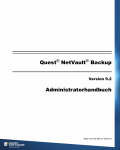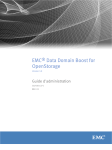Download Red Hat CERTIFICATE 7.3 RELEASE NOTES System information
Transcript
Rev: A01
Updated: May 15, 2014
Welcome to Greenplum Database 4.2.7.3
Greenplum Database is a massively parallel processing (MPP) database server that
supports next generation data warehousing and large-scale analytics processing. By
automatically partitioning data and running parallel queries, it allows a cluster of
servers to operate as a single database supercomputer performing tens or hundreds
times faster than a traditional database. It supports SQL, MapReduce parallel
processing, and data volumes ranging from hundreds of gigabytes, to hundreds of
terabytes.
This document contains pertinent release information about Greenplum
Database 4.2.7.3. For previous versions of the release notes for Greenplum Database,
go to Support Zone.
Note:
About Pivotal, Inc.
Greenplum is currently transitioning to a new corporate identity (Pivotal Software,
Inc.). During this transition, there will be some legacy instances of our former
corporate identity (Greenplum) appearing in our products and documentation. If you
have any questions or concerns, please do not hesitate to contact us through our web
site:
http://www.gopivotal.com/contact
About Greenplum Database 4.2.7.3
Greenplum Database 4.2.7.3 is a maintenance that contains a critical fix. Please refer
to the following sections for more information about this release.
•
Downloading Greenplum Database
•
Changed Feature
•
Supported Platforms
•
Resolved Issues in Greenplum Database 4.2.7.3
•
Known Issues in Greenplum Database 4.2.7.3
•
Upgrading to Greenplum Database 4.2.x.x
•
Greenplum Database Tools Compatibility
•
Greenplum Database Extensions Compatibility
•
Hadoop Distribution Compatibility
•
Greenplum Database 4.2 Documentation
Welcome to Greenplum Database 4.2.7.3
1
Greenplum Database 4.2.7.3 Release Notes
Downloading Greenplum Database
The Greenplum Database software and documentation can be accessed from the
following locations:
•
Greenplum Database 4.2.7.3 server software, and other Greenplum Database
4.2.7.3 software including tools and extension packages, can be downloaded from
the EMC Download Center.
•
Documentation for Greenplum Database 4.2.7.3 is available from the Pivotal
Documentation site.
Documentation for previous release versions of Greenplum Database, as well as
other Greenplum Database documentation, is available from Support Zone.
Changed Feature
Greenplum Database 4.2.7.3 supports:
•
Red Hat Enterprise Linux 6.5 64-bit.
•
SUSE 11 SP2
See “Supported Platforms” for information about operating system support.
Supported Platforms
Greenplum Database 4.2.7.3 runs on the following platforms:
•
Red Hat Enterprise Linux 64-bit 5.5, 5.6, 5.7, 6.1, 6.2, 6.4, and 6.5
•
SUSE Linux Enterprise Server 64-bit 10 SP4, 11 SP1, and 11 SP2
•
Solaris x86 64-bit v10 U7, U8, U9, U10
•
Oracle Unbreakable Linux 64-bit 5.5
•
CentOS 64-bit 5.5, 5.6, 5.7, 6.1, and 6.2
Greenplum Database 4.2.7.3 supports Data Domain Boost on Red Hat Enterprise
Linux.
Greenplum Database 4.2.7.3 supports Data Domain Boost SDK version 2.6.2.0 with
DDOS 5.2, 5.3 and 5.4.
GPDB 4.2.7.3 was certified against the following DCA versions:
•
DCA v1 - ISO_VERSION="1.2.1.1"
•
DCA v2 - ISO_VERSION="2.0.2.0"
For the most recent server platform support information for Greenplum
Database, check the EMC Support Matrix (ESM).
To access the ESM, go to the Support Zone home page and click the link E-Lab
Interoperability Navigator.
In the E-Lab Interoperability Navigator, search for Greenplum Database and add one
or more search results to the search cart. Click Get Results to display links to EMC
Support Statements.
Note:
Downloading Greenplum Database
2
Greenplum Database 4.2.7.3 Release Notes
Resolved Issues in Greenplum Database 4.2.7.3
The table below lists issues that are now resolved in Greenplum Database 4.2.7.3. For
issues resolved in prior releases, refer to the corresponding release notes available
from Support Zone.
Table 1 Resolved Issues in 4.2.7.3
Issue
Number
Category
Resolved
in
Description
22787
Monitoring:
gpperfmon
server
4.2.7.3
In some cases, the Greenplum Database gpmmon process failed. The
gpmmon process is used for Greenplum Database performance
monitoring.
22572
Loaders:
Copy/External
Tables
4.2.7.2
In some cases, SQL queries intermittently failed when reading from
external web tables and the web table was serving data over HTTP
from a traditional web server.
22442
Loaders:
gpfdist
4.2.7.2
The Greenplum Database Load Tools for Windows installation did not
include the gssapi and auth libraries. This issue has been resolved.
22317
Loaders:
gpfdist
4.2.7.2
When the Greenplum Database gpfdist utility was used with a named
pipe for a readable external table, and there was no data from the pipe
for more than 10 minutes, gpfdist failed.
22293
Backup and
Restore
4.2.7.2
Greenplum Database supports Data Domain DDOS 5.4. See
Supported Platforms for information about supported versions of Data
Domain Boost.
22219
20076
Query Planner
4.2.7.2
In certain queries that contain the median function and a GROUP BY
clause, the query planner produced an incorrect plan in which some
necessary columns were not projected in the operator nodes. This
caused an error when trying to look up the missing columns.
22266
Parser
4.2.7.1
When processing an SQL query, it was incorrectly assumed that the
data type for DISTINCT columns in a subquery took the outer query
data type when the outer query was part of a UNION. These types of
queries might have returned an error.
22254
Monitoring:
gpperfmon
server
4.2.7.1
In some cases, Greenplum Command Center displayed incorrect CPU
system information in the System Metrics tab.
22210
Backup and
Restore
4.2.7.1
When restoring sets of tables with the Greenplum Database
gpdbrestore utility, primary keys, indexes, and GRANT privileges were
not restored for filtered tables.
For tables with non-English characters (for example, table name and
records contained Korean or Chinese characters) primary keys,
indexes and GRANT privileges were not restored.
For tables with English characters, GRANT privileges were not
restored.
22077
Transaction
Management
4.2.7.1
A Greenplum Database internal function caused a buffer overrun when
a combination of the following information created a very long string:
user name, database name, and client host information.
22072
Backup and
Restore
4.2.7.1
An incremental backup created with gpcrondump did not generate the
correct restore list if some tables were dropped after an ACCESS
SHARED lock was released. Moved the lock on pg_class to the
gpcrondump utility from the gp_dump utility for better consistency.
Resolved Issues in Greenplum Database 4.2.7.3
3
Greenplum Database 4.2.7.3 Release Notes
Table 1 Resolved Issues in 4.2.7.3
Issue
Number
Category
Resolved
in
Description
22060
Functions and
Languages,
Resource
Management
4.2.7.1
The string_to_array function fails to produce an array when the input
string is larger than 250MB.
22045
Dispatch
4.2.7.1
Reporting errors when the maximum number of connections on
Greenplum Database segment instances were exceeded has been
enhanced.
• Error message for failed connections to segment instances are
printed to pg_log without enabling debug mode.
• The error message displayed on the client is
segworker group creation failed.
21880
Dispatch
4.2.7.1
An internal error message was displayed for an error that occurred for
an unsupported query plan with multiple writer segworker groups. The
message has been enhanced and provides a description and more
information about the context. This is the updated error message.
ERROR: Unsupported query plan with multiple writer gangs.
HINT: Likely caused by a user defined function that reads or modifies
data in a distributed table.
CONTEXT: SQL statement "SQL_statement"
21795
Fault Detection
and
Transitions
4.2.7.1
The Greenplum Database server configuration parameter gp_log_fts
specifies the level of fault probing messages written to the log file. Valid
values are off, terse, verbose, and debug. The verbose mode provides
minimal useful log messages.
After the value of gp_log_fts has been changed, stop and restart
Greenplum Database with the command gpstop -u for the value to take
affect.
21694
Query
Execution
4.2.7.1
When a Hash Join or Hash Aggregate operator spilled to disk for an
SQL query, the amount of workfile bytes read and written to disk was
incorrectly reported in the EXPLAIN ANALYZE output.
21630
19106
Resource
Management
4.2.7.1
Dropping the resource queue used by an active session from another
session would result in a postmaster reset on the master. This has
been changed. Now, instead of a reset, an error message is generated
in the affected session.
21545
Access
Methods
4.2.7.1
On some occasions when a pg_terminate_backend command was
issued, Greenplum Database encounters a PANIC and performs a
recovery.
21050
Monitoring:
gpperfmon
server,
Monitoring:
gpperfmon UI
4.2.7.1
Under some conditions, the Greenplum Command Center process
gpsmon would consume a large amount of memory.
20997
Monitoring:
gpperfmon
server,
Monitoring:
gpperfmon UI
4.2.7.1
The performance of Greenplum Command Center was slow when
processing log alerts from a very large log file.
The log processing has been enhanced and the Greenplum Database
server configuration parameter gpperfmon_log_alert_level can control
the growth of the gpperfmon log.
20970
Query
Execution
4.2.7.1
When Greenplum Command Center had been running for a long time,
the query it used for disk usage information could not be stopped.
Resolved Issues in Greenplum Database 4.2.7.3
4
Greenplum Database 4.2.7.3 Release Notes
Table 1 Resolved Issues in 4.2.7.3
Issue
Number
Category
Resolved
in
Description
20466
Catalog and
Metadata
4.2.7.1
If a constraint is created with the same name as an existing constraint,
the only way to remove the second constraint was to drop all
constraints.
The fix is to not allow duplicate constraint names. While creating a new
table or alter table for new constraint creation, duplicate constraint
name are not allowed.
19965
Query
Execution
4.2.7.1
In rare cases, wrong results were returned for a query when during
query processing the result of an operation is shared between multiple
parts of a query through a Shared Scan operator, and the readers of
the Shared Scan appear on both sides of a Join operator, and at least
two of the readers appear in the same plan slice. In this case, one of
the readers might read only zero tuples from the Shared Scan operator.
This has been fixed in this release.
The fix for this issue might increase the memory consumption for
certain queries where these conditions hold.
19930
Monitoring:
gpperfmon
server
4.2.7.1
In some cases, the Greenplum Command Center web server process
could consume a very large amount of memory. This caused the host
machine to run out of memory.
18646
Query
Execution
4.2.7.1
For some SQL queries that generated a query plan with Shared Scan
nodes above a Materialize node, the memory for the Shared Scan
node was being freed twice. In some cases, this caused a SEGV.
18635
Monitoring:
gpperfmon
server
4.2.7.1
In some cases, Greenplum Command Center incorrectly listed SQL
queries as active that were no longer active.
21725
Backup and
Restore
4.2.7
The following gpcrondump utility issues were caused when the root
table of a partitioned table is in a different schema than one of its
partitions (child tables) in a database:
• Creating a backup with the gpcrondump utility and specifying a list of
tables failed.
• Creating a backup of a database with the gpcrondump utility
succeeded. However, the database could not be restored.
21625
Dispatch
4.2.7
It was possible to send a query cancel error message from a QE
process to the QD process for a query that had completed. This caused
multiple statement executions to be out of sync between the QE and
the QD. In some cases, this led to the QE process to be hung
indefinitely.
21522
Backup and
Restore
4.2.7
The Greenplum Database utility pg_dump printed information-level
messages (messages with the label [INFO]) to stderr that were not
printed in previous releases. These messages were printed even when
pg_dump completed without errors.
19476
Client Access
Methods and
Tools
4.2.7
Running multiple gpload sessions simultaneously that loaded data into
the same table resulted in inconsistent data in the table.
19259
Transaction
Management
4.2.7
During high load situations, the clean up of an out-of-memory condition
was not handled correctly and caused a PANIC signal to be issued.
18858
Fault Detection
and
Transitions
4.2.7
Greenplum Database hung indefinitely due a disk that was failing or
had failed. Monitoring for hardware issues has been enhanced in
Greenplum Database.
Resolved Issues in Greenplum Database 4.2.7.3
5
Greenplum Database 4.2.7.3 Release Notes
Table 1 Resolved Issues in 4.2.7.3
Issue
Number
Category
Resolved
in
Description
18623
DDL and Utility
Statements
4.2.7
When an out-of-memory condition occurred during a hash table
expansion, the hash entry that was being created could have been in
an incomplete state. This resulted in misbehavior in the cleanup code.
18576
Transaction
Management
4.2.7
When an out-of-memory condition occurred on a lock acquisition code,
a hash table entry for the lock record could have been in an incomplete
state. This resulted in an invalid pointer handling during clean up.
Resolved Issues in Greenplum Database 4.2.7.3
6
Greenplum Database 4.2.7.3 Release Notes
Known Issues in Greenplum Database 4.2.7.3
This section lists the known issues in Greenplum Database 4.2.7.3. A workaround is
provided where applicable.
For known issues discovered in previous releases, including patch releases to
Greenplum Database 4.1 or 4.0.x, see the corresponding release notes, available from
Support Zone:
Table 2 All Known Issues in 4.2.7.3
Issue
Category
Description
22413
Query Planner
In some cases, an SQL query that contains the following returns incorrect
results: a combination of a median function with other aggregates where the
GROUP BY columns are a subset of the table's distribution columns.
The planner does not correctly redistribute the data to ensure proper
collocation of the join tuples, and as a result the join produces incorrect
results.
22560
Catalog and
Metadata
In PL/pgSQL user-defined functions, exceptions are not handled properly. If
the function contains exception blocks, the function should not issue DDL
commands, TRUNCATE commands, or inserts into append-only
column-oriented tables.
22442
Loaders: gpfdist
The Greenplum Database Load Tools for Windows is missing gssapi and auth
libraries.
Workaround: Install the Greenplum Database Client Tools for Windows. The Client
Tools include the missing libraries. The Load Tools will use the libraries from the
Client Tools.
22172
DDL and Utility
Statements
OLAP queries with a HAVING clause that filters for NULL on dimension
columns incorrectly return empty results.
20453
Query Planner
For SQL queries of either of the following forms:
SELECT columns FROM table WHERE table.column NOT IN subquery;
SELECT columns FROM table WHERE table.column = ALL subquery;
tuples that satisfy both of the following conditions are not included in the
result set:
• table.column is NULL.
• subquery returns the empty result.
21724
Query Planner
Greenplum Database executes an SQL query in two stages if a scalar
subquery is involved. The output of the first stage plan is fed into the second
stage plan as a external parameter. If the first stage plan generates zero
tuples and directly contributes to the output of the second stage plan,
incorrect results might be returned.
21838
Backup and
Restore
When restoring sets of tables with the Greenplum Database utility
gpdbrestore, the table schemas must be defined in the database. If a table’s
schema is not defined in the database, the table is not restored. When
performing a full restore, the database schemas are created when the tables
are restored.
Workaround: Before restoring a set of tables, create the schemas for the tables in
the database.
21129
DDL and Utility
Statements
SSL is only supported on the master host. It is not supported on segment
hosts.
Known Issues in Greenplum Database 4.2.7.3
7
Greenplum Database 4.2.7.3 Release Notes
Table 2 All Known Issues in 4.2.7.3
Issue
Category
Description
20822
Backup and
Restore
Special characters such as !, $, #, and @ cannot be used in the password for
the Data Domain Boost user when specifying the Data Domain Boost
credentials with the gpcrondump options --ddboost-host and --ddboost-user.
18247
DDL and Utility
Statements
TRUNCATE command does not remove rows from a sub-table of a partitioned
table. If you specify a sub-table of a partitioned table with the TRUNCATE
command, the command does not remove rows from the sub-table and its
child tables.
Workaround: Use the ALTER TABLE command with the TRUNCATE PARTITION
clause to remove rows from the sub-table and its child tables.
19788
Replication:
Resync,
Transaction
Management
In some rare circumstances, performing a full recovery with gprecoverseg
fails due to inconsistent LSN.
Workaround: Stop and restart the database. Then perform a full recovery with
gprecoverseg.
19772
Interconnect
After installing Greenplum Database 4.2.4, downgrading the Greenplum
Database installation to a previous minor version causes a crash.
Workaround: Before downgrading Greenplum Database 4.2.4 to a previous minor
version, change the value for the Greenplum Database parameter
gp_interconnect_type from UDPIFC to a supported value such as UDP. The
parameter value UDPIFC was introduced in Greenplum Database 4.2.4 and is not
valid in previous versions.
19705
Loaders: gpload
gpload fails on Windows XP with Python 2.6.
Workaround: Install Python 2.5 on the system where gpload is installed.
19493
19464
19426
Backup and
Restore
The gpcrondump and gpdbrestore utilities do not handle errors returned by DD
Boost or Data Domain correctly.
These are two examples:
• If invalid Data Domain credentials are specified when setting the Data Domain
Boost credentials with the gpcrondump utility, the error message does not
indicate that invalid credentials were specified.
• Restoring a Greenplum database from a Data Domain system with gpdbrestore
and the --ddboost option indicates success even though segment failures
occured during the restore.
Workaround: The errors are logged in the master and segment server backup or
restore status and report files. Scan the status and report files to check for error
messages.
19278
Backup and
Restore
When performing a selective restore of a partitioned table from a full backup
with gpdbrestore, the data from leaf partitions are not restored.
Workaround: When doing a selective restore from a full backup, specify the
individual leaf partitions of the partitioned tables that are being restored.
Alternatively, perform a full backup, not a selective backup.
15692
17192
Backup and
Restore
Greenplum Database’s implementation of RSA lock box for Data Domain
Boost changes backup and restore requirements for customers running
SUSE.
The current implementation of the RSA lock box for Data Domain Boost login
credential encryption only supports customers running on Red Hat Enterprise
Linux.
Workaround: If you run Greenplum Database on SUSE, use NFS as your backup
solution. See the Greenplum Database System Administrator Guide for information
on setting up a NFS backup.
Known Issues in Greenplum Database 4.2.7.3
8
Greenplum Database 4.2.7.3 Release Notes
Table 2 All Known Issues in 4.2.7.3
Issue
Category
Description
18850
Backup and
Restore
Data Domain Boost credentials cannot be set up in some environments due to the
absence of certain libraries (for example, libstdc++) expected to reside on the
platform.
Workaround: Install the missing libraries manually on the system.
18851
Backup and
Restore
When performing a data-only restore of a particular table, it is possible to introduce
data into Greenplum Database that contradicts the distribution policy of that table.
In such cases, subsequent queries may return unexpected and incorrect results. To
avoid this scenario, we suggest you carefully consider the table schema when
performing a restore.
18774
Loaders
External web tables that use IPv6 addresses must include a port number.
18713
Catalog and
Metadata
Drop language plpgsql cascade results in a loss of gp_toolkit functionality.
Workaround: Reinstall gp_toolkit.
18710
Management
Scripts Suite
Greenplum Management utilities cannot parse IPv6 IP addresses.
Workaround: Always specify IPv6 hostnames rather than IP addresses
18703
Loaders
The bytenum field (byte offset in the load file where the error occurred) in the error
log when using gpfdist with data in text format errors is not populated, making it
difficult to find the location of an error in the source file.
12468
Management
Scripts Suite
gpexpand --rollback fails if an error occurs during expansion such that it leaves
the database down
gpstart also fails as it detects that expansion is in progress and suggests to run
gpexpand --rollback which will not work because the database is down.
Workaround: Run gpstart -m to start the master and then run rollback,
18785
Loaders
Running gpload with the --ssl option and the relative path of the source file
results in an error that states the source file is missing.
Workaround: Provide the full path in the yaml file or add the loaded data file to the
certificate folder.
18414
Loaders
Unable to define external tables with fixed width format and empty line delimiter
when file size is larger than gpfdist chunk (by default, 32K).
14640
Backup and
Restore
gpdbrestore outputting incorrect non-zero error message.
When performing single table restore, gpdbrestore gives warning messages about
non-zero tables however prints out zero rows.
17285
Backup and
Restore
NFS backup with gpcrondump -c can fail.
In circumstances where you haven't backed up to a local disk before, backups to
NFS using gpcrondump with the -c option can fail. On fresh systems where a
backup has not been previously invoked there are no dump files to cleanup and the
-c flag will have no effect.
Workaround: Do not run gpcrondump with the -c option the first time a backup is
invoked from a system.
17837
Upgrade/
Downgrade
Major version upgrades internally depend on the gp_toolkit system schema. The
alteration or absence of this schema may cause upgrades to error out during
preliminary checks.
Workaround: To enable the upgrade process to proceed, you need to reinstall the
gp_toolkit schema in all affected databases by applying the SQL file found here:
$GPHOME/share/postgresql/gp_toolkit.sql.
Known Issues in Greenplum Database 4.2.7.3
9
Greenplum Database 4.2.7.3 Release Notes
Table 2 All Known Issues in 4.2.7.3
Issue
Category
Description
17513
Management
Scripts Suite
Running more than one gpfilespace command concurrently with itself to move
either temporary files (--movetempfilespace) or transaction files
(--movetransfilespace) to a new filespace can in some circumstances cause
OID inconsistencies.
Workaround: Do not run more than one gpfilespace command concurrently with
itself. If an OID inconsistency is introduced gpfilespace --movetempfilespace or
gpfilespace --movetransfilespace can be used to revert to the default
filespace.
17780
DDL/DML:
Partitioning
ALTER TABLE ADD PARTITION inheritance issue
When performing an ALTER TABLE ADD PARTITION operation, the resulting parts
may not correctly inherit the storage properties of the parent table in cases such as
adding a default partition or more complex subpartitioning. This issue can be
avoided by explicitly dictating the storage properties during the ADD PARTITION
invocation. For leaf partitions that are already afflicted, the issue can be rectified
through use of EXCHANGE PARTITION.
17795
Management
Scripts Suite
Under some circumstances, gppkg on SUSE is unable to correctly interpret error
messages returned by rpm.
On SUSE, gppkg is unable to operate correctly under circumstances that require a
non-trivial interpretation of underlying rpm commands. This includes scenarios that
result from overlapping packages, partial installs, and partial uninstalls.
17604
Security
A Red Hat Enterprise Linux (RHEL) 6.x security configuration file limits the number
of processes that can run on gpadmin.
RHEL 6.x contains a security file (/etc/security/limits.d/90-nproc.conf) that limits
available processes running on gpadmin to 1064.
Workaround: Remove this file or increase the processes to 131072.
17415
Installer
When you run gppkg -q -info<some gppkg>, the system shows the GPDBversion
as main build dev.
17334
Management
Scripts Suite
You may see warning messages that interfere with the operation of management
scripts when logging in.
Greenplum recommends that you edit the /etc/motd file and add the warning
message to it. This will send the messages to are redirected to stdout and not
stderr. You must encode these warning messages in UTF-8 format.
17221
Resource
Management
Resource queue deadlocks may be encountered if a cursor is associated with a
query invoking a function within another function.
17113
Management
Scripts Suite
Filespaces are inconsistent when the Greenplum database is down.
Filespaces become inconsistent in case of a network failure. Greenplum
recommends that processes such as moving a filespace be done in an environment
with an uninterrupted power supply.
17189
Loaders: gpfdist
gpfdist shows the error “Address already in use” after successfully binding to
socket IPv6.
Greenplum supports IPv4 and IPv6. However, gpfdist fails to bind to socket IPv4,
and shows the message “Address already in use”, but binds successfully to socket
IPv6.
Known Issues in Greenplum Database 4.2.7.3
10
Greenplum Database 4.2.7.3 Release Notes
Table 2 All Known Issues in 4.2.7.3
Issue
Category
Description
16519
Backup and
Restore
Limited data restore functionality and/or restore performance issues can occur
when restoring tables from a full database backup where the default backup
directory was not used.
In order to restore from backup files not located in the default directory you can use
the -R to point to another host and directory. This is not possible however, if you
want to point to a different directory on the same host (NFS for example).
Workaround: Define a symbolic link from the default dump directory to the
directory used for backup, as shown in the following example:
1. Perform a full Database Backup to a specific NFS directory:
$ gpcrondump -x <db_name> -z -u /backup/DCA-93 -a
2. Create a file listing the segment servers:
$ vi /home/gpadmin/segments
sdw1
sdw2
sdw3
….
3. Remove the relevant date folder from db_dumps directories on the master and
segments:
$ rm -r /data/master/gpseg-1/db_dumps/20120619
$ gpssh -f segments 'rm -r
/data1/primary/gpseg*/db_dumps/20120619'
$ gpssh -f segments 'rm -r
/data2/primary/gpseg*/db_dumps/20120619'
4. Create a symbolic link between the master and segment directories and the
directory to which you backed up in step 1. Only the master and sdw1 was
shown here, write a script for the remaining segments:
$ ln -s /backup/DCA-93/db_dumps/20120619
/data/master/gpseg-1/db_dumps/20120619
$ gpssh -h sdw1 'ln -s /backup/DCA-93/db_dumps/20120619
/data1/primary/gpseg0/db_dumps/20120619'
$ gpssh -h sdw1 'ln -s /backup/DCA-93/db_dumps/20120619
/data1/primary/gpseg1/db_dumps/20120619'
$ gpssh -h sdw1 'ln -s /backup/DCA-93/db_dumps/20120619
/data1/primary/gpseg2/db_dumps/20120619'
$ gpssh -h sdw1 'ln -s /backup/DCA-93/db_dumps/20120619
/data2/primary/gpseg3/db_dumps/20120619'
$ gpssh -h sdw1 'ln -s /backup/DCA-93/db_dumps/20120619
/data2/primary/gpseg4/db_dumps/20120619'
$ gpssh -h sdw1 'ln -s /backup/DCA-93/db_dumps/20120619
/data2/primary/gpseg5/db_dumps/20120619'
5. Restore from backup files:
$ gpdbrestore -t 20120619061835 -T <schema.table> -a
6. Remove the symbolic links
$ rrm -r /data/master/gpseg-1/db_dumps/20120619
$ gpssh -f segments 'rm -r
/data1/primary/gpseg*/db_dumps/20120619'
$ gpssh -f segments 'rm -r
/data2/primary/gpseg*/db_dumps/20120619'
Known Issues in Greenplum Database 4.2.7.3
11
Greenplum Database 4.2.7.3 Release Notes
Table 2 All Known Issues in 4.2.7.3
Issue
Category
Description
16064
Backup and
Restore
Restoring a compressed dump with the --ddboost option displays incorrect
dump parameter information.
When using gpdbrestore --ddboost to restore a compressed dump, the
restore parameters incorrectly show “Restore compressed dump = Off”. This
error occurs even if gpdbrestore passes the --gp-c option to use gunzip for
in-line de-compression.
15899
Backup and
Restore
When running gpdbrestore with the list (-L) option, external tables do not
appear; this has no functional impact on the restore job.
Known Issues in Greenplum Database 4.2.7.3
12
Greenplum Database 4.2.7.3 Release Notes
Upgrading to Greenplum Database 4.2.x.x
The upgrade path supported for this release is Greenplum Database 4.1.x.x to
Greenplum Database 4.2.x.x. The minimum recommended upgrade path for this
release is from Greenplum Database version 4.1.1.5. If you have an earlier major
version of the database, you must first upgrade to version 4.1.x.
For detailed upgrade procedures and information, see the following sections:
•
Upgrading from 4.2.x.x to 4.2.7.3
•
Upgrading from 4.1.x.x to 4.2.x.x
•
For Users Running Greenplum Database 4.0.x.x
•
For Users Running Greenplum Database 3.3.x.x
•
Troubleshooting a Failed Upgrade
Upgrading from 4.2.x.x to 4.2.7.3
An upgrade from 4.2.x.x to 4.2.7.3 involves stopping Greenplum Database, updating
the Greenplum Database software binaries, and restarting Greenplum Database.
1.
Log in to your Greenplum Database master host as the Greenplum administrative
user:
$ su - gpadmin
2.
Perform a smart shutdown of your current Greenplum Database 4.2.x.x system
(there can be no active connections to the database):
$ gpstop
3.
Run the installer for 4.2.7.3 on the Greenplum Database master host. When
prompted, choose an installation location in the same base directory as your
current installation. For example:
/usr/local/greenplum-db-4.2.2.x
4.
Edit the environment of the Greenplum Database superuser (gpadmin) and make
sure you are sourcing the greenplum_path.sh file for the new installation. For
example change the following line in .bashrc or your chosen profile file:
source /usr/local/greenplum-db-4.2.x.x/greenplum_path.sh
to:
source /usr/local/greenplum-db-4.2.7.3/greenplum_path.sh
Or if you are sourcing a symbolic link (/usr/local/greenplum-db) in your
profile files, update the link to point to the newly installed version. For example:
$ rm /usr/local/greenplum-db
$ ln -s /usr/local/greenplum-db-4.2.7.3
/usr/local/greenplum-db
5.
Source the environment file you just edited. For example:
$ source ~/.bashrc
Upgrading to Greenplum Database 4.2.x.x
13
Greenplum Database 4.2.7.3 Release Notes
6.
Run the gpseginstall utility to install the 4.2.7.3 binaries on all the segment
hosts specified in the hostfile. For example:
$ gpseginstall -f hostfile
7.
After all segment hosts have been upgraded, you can log in as the gpadmin user
and restart your Greenplum Database system:
$ su - gpadmin
$ gpstart
8.
If you are utilizing Data Domain Boost, you have to re-enter your DD Boost
credentials after upgrading from Greenplum Database 4.2.1 to 4.2.7.3 as follows:
gpcrondump --ddboost-host ddboost_hostname --ddboost-user
ddboost_user
Note that if you do not reenter your login credentials after an upgrade, your
backup will never start because the Greenplum Database cannot connect to the
Data Domain system. You will receive an error advising you to check your login
credentials.
Upgrading from 4.1.x.x to 4.2.x.x
This section describes how you can upgrade from Greenplum Database 4.1.x.x or later
to Greenplum Database 4.2.x.x. For users running versions prior to 4.1.x.x of
Greenplum Database, see the following:
•
For Users Running Greenplum Database 4.0.x.x
•
For Users Running Greenplum Database 3.3.x.x
Planning Your Upgrade
Before you begin your upgrade, make sure the master and all segments (data
directories and filespace) have at least 2GB of free space.
Prior to upgrading your database, Greenplum recommends that you run a pre-upgrade
check to verify your database is healthy.
You can perform a pre-upgrade check by executing the gpmigrator (_mirror) utility
with the --check-only option.
For example:
source $new_gphome/greenplum_path.sh;
gpmigrator_mirror --check-only $old_gphome $new_gphome
Note: Performing a pre-upgrade check of your database with the gpmigrator
(_mirror) utility should done during a database maintenance period. When the utility
checks the database catalog, users cannot access the database.
Some of the rules for partitioned tables are different in 4.2 than in previous releases.
gpmigrator detects partitioned tables that violate these new rules and aborts the
upgrade. In most cases, gpmigrator will create a repair script you can run to bring
your 4.1 Greenplum Database into line with the new rules in 4.2. See Upgrading
Partitioned Tables with Constraints for more details.
Upgrading Partitioned Tables with Constraints
Partition tables with CHECK, PRIMARY KEY, or UNIQUE constraints must be updated
prior to upgrading:
Upgrading to Greenplum Database 4.2.x.x
14
Greenplum Database 4.2.7.3 Release Notes
•
Regular CHECK, PRIMARY KEY, or UNIQUE constraints added by database users
usually appear on every sub-table of the partitioned table. Their names may need
to be adjusted. If necessary, gpmigrator creates a repair script to do this.
•
PRIMARY KEY and UNIQUE constraints on partitioned tables that do not include all
the columns of the partition key need to be removed. If needed, gpmigrator
creates a repair script to do this. Note that the unique index underlying the
constraint remains and provides the same protection against duplicate keys as did
the constraint. As was previously the case, it is possible for different parts of the
partitioned table to contain the same key value.
•
If the added constraints appear on some but not all of the sub-tables that make up
a partitioned table, they cannot be updated automatically. In this case, you need to
either drop the irregular constraints or add the missing constraints. Other causes of
irregularity may exist but are rare. Greenplum recommends that you contact
support if you encounter any issues with partitioned tables that cannot be resolved
automatically with gpmigrator.
Upgrade Procedure
This section divides the upgrade into the following phases: pre-upgrade preparation,
software installation, upgrade execution, and post-upgrade tasks.
We have also provided you with an Upgrade Checklist that summarizes this
procedure.
Important: Carefully evaluate each section and perform all required and conditional
steps. Failing to perform any of these steps can result in an aborted upgrade,
placing your system in an unusable or even unrecoverable state.
Pre-Upgrade Preparation (on your 4.1.x system)
Perform these steps on your current 4.1.x Greenplum Database system. This
procedure is performed from your Greenplum master host and should be executed by
the Greenplum superuser (gpadmin).
1.
Log in to the Greenplum Database master as the gpadmin user:
$ su - gpadmin
2.
(optional) Vacuum all databases prior to upgrade. For example:
$ vacuumdb database_name
3.
(optional) Clean out old server log files from your master and segment data
directories. For example, to remove log files from 2011 from your segment hosts:
$ gpssh -f seg_host_file -e 'rm
/gpdata/*/gp*/pg_log/gpdb-2011-*.csv'
Running Vacuum and cleaning out old logs files is not required, but it will
reduce the size of Greenplum Database files to be backed up and migrated.
Note:
4.
Run gpstate to check for failed segments.
$ gpstate
Upgrading to Greenplum Database 4.2.x.x
15
Greenplum Database 4.2.7.3 Release Notes
5.
If you have failed segments, you must recover them using gprecoverseg before
you can upgrade.
$ gprecoverseg
Note: It might be necessary to restart the database if the preferred role does not
match the current role; for example, if a primary segment is acting as a mirror
segment or a mirror segment is acting as a primary segment.
6.
Copy or preserve any additional folders or files (such as backup folders) that you
have added in the Greenplum data directories or $GPHOME directory. Only files or
folders strictly related to Greenplum Database operations are preserved by the
migration utility.
Install the Greenplum Software Binaries
1.
Download or copy the installer file to the Greenplum Database master host.
2.
Unzip the installer file. For example:
# unzip greenplum-db-4.2.x.x-PLATFORM.zip
3.
Launch the installer using bash. For example:
# /bin/bash greenplum-db-4.2.x.x-PLATFORM.bin
4.
The installer will prompt you to accept the Greenplum Database license
agreement. Type yes to accept the license agreement.
5.
The installer will prompt you to provide an installation path. Press ENTER to
accept the default install path (for example:
/usr/local/greenplum-db-4.2.x.x), or enter an absolute path to an install
location. You must have write permissions to the location you specify.
6.
The installer will install the Greenplum software and create a greenplum-db
symbolic link one directory level above your version-specific Greenplum
installation directory. The symbolic link is used to facilitate patch maintenance
and upgrades between versions. The installed location is referred to as $GPHOME.
7.
Source the path file from your new 4.2.x.x installation. For example:
$ source /usr/local/greenplum-db-4.2.x.x/greenplum_path.sh
8.
Run the gpseginstall utility to install the 4.2.3.x binaries on all the segment
hosts specified in the hostfile. For example:
$ gpseginstall -f hostfile
Upgrade Execution
During upgrade, all client connections to the master will be locked out. Inform all
database users of the upgrade and lockout time frame. From this point onward, users
should not be allowed on the system until the upgrade is complete.
9.
Source the path file from your old 4.1.x.x installation. For example:
$ source /usr/local/greenplum-db-4.1.1.5/greenplum_path.sh
Upgrading to Greenplum Database 4.2.x.x
16
Greenplum Database 4.2.7.3 Release Notes
10. (optional
but strongly recommended) Back up all databases in your Greenplum
Database system using gpcrondump (or zfs snapshots on Solaris systems). See the
Greenplum Database Administrator Guide for more information on how to do
backups using gpcrondump. Make sure to secure your backup files in a location
outside of your Greenplum data directories.
11. If
your system has a standby master host configured, remove the standby master
from your system configuration. For example:
$ gpinitstandby -r
12. Perform
a clean shutdown of your current Greenplum system. For example:
$ gpstop
13. Source
the path file from your new 4.2.x.x installation. For example:
$ source /usr/home/greenplum-db-4.2.x.x/greenplum_path.sh
14. Update
a.
your environment so it is sourcing your new 4.2.x.x installation.
For example, update the greenplum-db symbolic link on the master and
standby master to point to the new 4.2.x.x installation directory. For example
(as root):
# rm -rf /usr/local/greenplum-db
# ln -s /usr/local/greenplum-db-4.2.x.x
/usr/local/greenplum-db
# chown -R gpadmin /usr/local/greenplum-db
b.
Using gpssh, also update the greenplum-db symbolic link on all of your
segment hosts. For example (as root):
# gpssh -f segment_hosts_file
=> rm -rf /usr/local/greenplum-db
=> ln -s /usr/local/greenplum-db-4.2.x.x
/usr/local/greenplum-db
=> chown -R gpadmin /usr/local/greenplum-db
=> exit
15. (optional
but recommended) Prior to running the migration, perform a
pre-upgrade check to verify that your database is healthy by executing the 4.2.x.x
version of the gpmigrator utility with the --check-only option. For example:
# gpmigrator_mirror --check-only
/usr/local/greenplum-db-4.1.1.5
/usr/local/greenplum-db-4.2.x.x
16. As gpadmin,
run the 4.2.x.x version of the migration utility specifying your old
and new GPHOME locations. If your system has mirrors, use gpmigrator_mirror.
If your system does not have mirrors, use gpmigrator. For example on a system
with mirrors:
$ su - gpadmin
$ gpmigrator_mirror /usr/local/greenplum-db-4.1.1.5
/usr/local/greenplum-db-4.2.x.x
Upgrading to Greenplum Database 4.2.x.x
17
Greenplum Database 4.2.7.3 Release Notes
Note: If the migration does not complete successfully, contact Customer Support
(see “Troubleshooting a Failed Upgrade” on page 21).
17. The
migration can take a while to complete. After the migration utility has
completed successfully, the Greenplum Database 4.2.x.x system will be running
and accepting connections.
Note: After the migration utility has completed, the resynchronization of the
mirror segments with the primary segments continues. Even though the system is
running, the mirrors are not active until the resynchronization is complete.
Post-Upgrade (on your 4.2.x.x system)
18. If
your system had a standby master host configured, reinitialize your standby
master using gpinitstandby:
$ gpinitstandby -s standby_hostname
19. If
your system uses external tables with gpfdist, stop all gpfdist processes on
your ETL servers and reinstall gpfdist using the compatible Greenplum
Database 4.2.x.x Load Tools package. Application Packages are available from
the EMC Download Center.
20. Rebuild
any custom modules against your 4.2.x.x installation (for example, any
shared library files for user-defined functions in $GPHOME/lib).
21. Greenplum
Database 4.2.x.x introduced the gppkg utility to install Greenplum
Database extensions. If you were previously using any PostgreSQL extensions
such as pgcrypto, PL/R, PL/Java, PL/Perl, and PostGIS, download the
corresponding packages from the EMC Download Center, and install using this
new utility. See the Greenplum Database Administrator Guide 4.2 or later for
usage details.
22. If
you want to utilize the Greenplum Command Center management tool, install
the latest Command Center Console and update your environment variable to
point to the latest Command Center binaries (source the gpperfmon_path.sh file
from your new installation).
Note that the Greenplum Command Center management tool replaces Greenplum
Performance Monitor.
Command Center Console packages are available from the EMC Download
Center or Pivotal Network.
23. Inform
all database users of the completed upgrade. Tell users to update their
environment to source the Greenplum Database 4.2.x.x installation (if necessary).
Upgrading to Greenplum Database 4.2.x.x
18
Greenplum Database 4.2.7.3 Release Notes
Upgrade Checklist
This checklist provides a quick overview of all the steps required for an upgrade from
4.1.x.x to 4.2.x.x. Detailed upgrade instructions are provided in the Upgrade
Procedure section.
Pre-Upgrade Preparation (on your current system)
* 4.1.x.x system is up and available
Log in to your master host as the gpadmin user (your Greenplum superuser).
(Optional) Run VACUUM on all databases,
(Optional) Remove old server log files from pg_log in your master and
segment data directories.
Check for and recover any failed segments (gpstate, gprecoverseg).
Copy or preserve any additional folders or files (such as backup folders).
Install the Greenplum Database 4.2.x.x binaries on all Greenplum hosts.
Inform all database users of the upgrade and lockout time frame.
Upgrade Execution
* The system will be locked down to all user activity during the upgrade process
Backup your current databases.
Remove the standby master (gpinitstandby -r).
Do a clean shutdown of your current system (gpstop).
Update your environment to source the new Greenplum Database 4.2.x.x
installation.
Run the upgrade utility (gpmigrator_mirror if you have mirrors,
gpmigrator if you do not).
After the upgrade process finishes successfully, your 4.2.x.x system will be
up and running.
Post-Upgrade (on your 4.2.x.x system)
* The 4.2.x.x system is up
Reinitialize your standby master host (gpinitstandby).
Upgrading to Greenplum Database 4.2.x.x
19
Greenplum Database 4.2.7.3 Release Notes
Upgrade gpfdist on all of your ETL hosts.
Rebuild any custom modules against your 4.2.x.x installation.
Download and install any Greenplum Database extensions.
(Optional) Install the latest Command Center Console and update your
environment to point to the latest Command Center binaries.
Inform all database users of the completed upgrade.
For Users Running Greenplum Database 4.0.x.x
Users on a release prior to 4.1.x.x cannot upgrade directly to 4.2.x.x.
•
Upgrade from your current release to 4.1.x.x (follow the upgrade instructions in
the latest Greenplum Database 4.1.x.x release notes available on Support Zone).
•
Follow the upgrade instructions in these release notes for Upgrading from 4.1.x.x
to 4.2.x.x.
For Users Running Greenplum Database 3.3.x.x
Users on a release prior to 4.0.x.x cannot upgrade directly to 4.1.x.
•
Upgrade from your current release to 4.0.x.x (follow the upgrade instructions in
the latest Greenplum Database 4.0.x.x release notes available on Support Zone).
•
Upgrade the 4.0.x.x release to 4.1.x.x (follow the upgrade instructions in the latest
Greenplum Database 4.1.x.x release notes available on Support Zone).
•
Follow the upgrade instructions in these release notes for Upgrading from 4.1.x.x
to 4.2.x.x.
Upgrading to Greenplum Database 4.2.x.x
20
Greenplum Database 4.2.7.3 Release Notes
Troubleshooting a Failed Upgrade
If you experience issues during the migration process, go to the Support page at
Support Zone or contact Greenplum customer support at one of the following
numbers:
United States: 800-782-4362 (1-800-SVC-4EMC)
Canada: 800-543-4782
Worldwide: +1-508-497-7901
Be prepared to provide the following information:
•
A completed Upgrade Procedure.
•
Log output from gpmigrator and gpcheckcat (located in ~/gpAdminLogs)
Greenplum Database Tools Compatibility
Client Tools
Greenplum releases a number of client tool packages on various platforms that can be
used to connect to Greenplum Database and the Greenplum Command Center
management tool. The following table describes the compatibility of these packages
with this Greenplum Database release.
Tool packages are available from the EMC Download Center.
Table 3 Greenplum Database Tools Compatibility
Client Package
Description of Contents
Client Version
Server Versions
Greenplum Clients
Greenplum Database Command-Line
Interface (psql)
4.2.7
4.2.7
Greenplum MapReduce (gpmapreduce)1
Greenplum Connectivity
Standard PostgreSQL Database Drivers
(ODBC, JDBC)
PostgreSQL Client C API (libpq)
4.2.7
4.2.7
Greenplum Loaders
Greenplum Database Parallel Data
Loading Tools (gpfdist, gpload)
4.2.7
4.2.7
Greenplum Command
Center
Greenplum Database management tool.
1.2.0.1
4.2.7
1. gpmapreduce is not available on Windows.
The Greenplum Database Client Tools, Load Tools, and Connectivity Tools are
supported on these platforms:
•
AIX 5.3L (32-bit)
•
AIX 5.3L and AIX 6.1 (64-bit)
•
Apple OSX on Intel processors (32-bit)
•
HP-UX 11i v3 (B.11.31) Intel Itanium (Client and Load Tools only)
•
Red Hat Enterprise Linux i386 (RHEL 5)
•
Red Hat Enterprise Linux x86_64 (RHEL 4)
Greenplum Database Tools Compatibility
21
Greenplum Database 4.2.7.3 Release Notes
•
Red Hat Enterprise Linux x86_64 (RHEL 5 and RHEL 6)
•
Solaris 10 i386
•
Solaris 10 SPARC32
•
Solaris 10 SPARC64
•
Solaris 10 x86_64
•
Solaris 9 SPARC32
•
SUSE Linux Enterprise Server x86_64 (SLES 10 and SLES 11)
•
Windows 7 (32-bit and 64-bit)
•
Windows Server 2003 R2 (32-bit and 64-bit)
•
Windows Server 2008 R2 (64-bit)
•
Windows XP (32-bit and 64-bit)
Greenplum GPText
GPText enables processing mass quantities of raw text data (such as social media
feeds or e-mail databases) into mission-critical information that guides business and
project decisions. GPText joins the Greenplum Database massively
parallel-processing database server with Apache Solr enterprise search.
GPText requires Greenplum Database. See the GPText release notes for the required
version of Greenplum Database.
Greenplum Database Extensions Compatibility
Greenplum Database delivers an agile, extensible platform for in-database analytics,
leveraging the system’s massively parallel architecture. With Release 4.2.x.x,
Greenplum enables turn-key in-database analytics via Greenplum Extensions.
You can download Greenplum extensions packages from the EMC Download Center,
and install them using the Greenplum Packager Manager (gppkg). See the Greenplum
Database Administrator Guide 4.2 or later for details.
Note that Greenplum Package Manager installation files for extension packages may
release outside of standard Database release cycles. Therefore, for the latest install and
configuration information regarding any supported database package/extension, go to
the Support site and download Primus Article 288189 from our knowledge base
(Requires a valid login to the EMC Support site).
The following table provides information about the compatibility of the Greenplum
Database Extensions and their components with this Greenplum Database release.
Note that the PL/Python database extension is already included with the standard
Greenplum database distribution.
Greenplum Database Extensions Compatibility
22
Greenplum Database 4.2.7.3 Release Notes
Table 4 Greenplum Database Extensions Compatibility
Extension Components
Greenplum Database Extension
Name
Version
PostGIS
2.0.3
Proj
4.8.0
Geos
3.3.8
PostGIS
1.4.2
Proj
4.7.0
Geos
3.2.2
PL/Java
Based on 1.4.0
Java JDK
1.6.0_26 Update 31
PL/R
8.3.0.12
R
2.13.0
PL/Perl
Based on
PostgreSQL 9.1
Perl
5.12.4 on
RHEL 6.x
5.5.8 on
RHEL 5.x, SUSE 10
PL/Perl
Based on
PostgreSQL 9.1
Perl
5.12.4 on
RHEL 5.x, SUSE 10
PL/Perl
Based on
PostgreSQL 9.1
Perl
5.12.4 on
RHEL 5.x, SUSE 10
Pgcrypto 1.0 for Greenplum Database 4.2.x.x
Pgcrypto
Based on
PostgreSQL 8.3
Greenplum Hadoop File System
gphdfs
1.1
gphdfs
1.2
gphdfs
1.3
gphdfs
1.4
MADlib
Based on MADlib
version 0.7.0
PostGIS 2.0 for Greenplum Database 4.2.x.x
PostGIS 1.0 for Greenplum Database 4.2.x.x
PL/Java 1.0 for Greenplum Database 4.2.x.x
PL/R 1.0 for Greenplum Database 4.2.x.x
PL/Perl 1.2 for Greenplum Database 4.2.x.x
PL/Perl 1.1 for Greenplum Database 4.2.x.x
PL/Perl 1.0 for Greenplum Database 4.2.x.x
MADlib 1.4 for Greenplum Database 4.2.x.x
Greenplum Database Extensions Compatibility
23
Greenplum Database 4.2.7.3 Release Notes
Hadoop Distribution Compatibility
Use the gppkg utility to install the gNet package containing the jar file for the
extensions, the libraries, and the documentation for the gphdfs extensions. To install
the correct distribution, refer to the following Hadoop extensions compatibility
matrix:
Table 5 Hadoop Extensions Compatibility
Hadoop Distribution
Version
Pivotal HD
Pivotal HD 1.01
Greenplum HD
Greenplum HD 1.1
Greenplum HD 1.2
Cloudera
cdh3u2
cdh3u4
CDH4.1 with MRv1
Greenplum MR
Greenplum MR 1.0
Greenplum MR 1.2
1. A distribution of Hadoop 2.0
Hadoop Distribution Compatibility
24
Greenplum Database 4.2.7.3 Release Notes
Greenplum Database 4.2 Documentation
For the latest Greenplum Database documentation go to Pivotal Documentation.
Greenplum documentation is provided in PDF format.
Table 6 Greenplum Database Documentation
Title
Revision
Greenplum Database 4.2.7.3 Release Notes
A01
Greenplum Database 4.2 Installation Guide
A11
Greenplum Database 4.2 Database Administrator Guide
A08
Greenplum Database 4.2 System Administrator Guide
A12
Greenplum Database 4.2 Reference Guide
A12
Greenplum Database 4.2 Utility Guide
A12
Greenplum Database 4.2 Client Tools for UNIX
A05
Greenplum Database 4.2 Client Tools for Windows
A05
Greenplum Database 4.2 Connectivity Tools for UNIX
A04
Greenplum Database 4.2 Connectivity Tools for Windows
A03
Greenplum Database 4.2 Load Tools for UNIX
A05
Greenplum Database 4.2 Load Tools for Windows
A05
Greenplum Command Center 1.2 Administrator Guide
A01
Greenplum Database 4.2 Documentation
25
Greenplum Database 4.2.7.3 Release Notes
Copyright © 2014 Pivotal Software, Inc. All rights reserved.
Pivotal Software, Inc. believes the information in this publication is accurate as of its publication date. The
information is subject to change without notice.
THE INFORMATION IN THIS PUBLICATION IS PROVIDED "AS IS." PIVOTAL SOFTWARE, INC. ("Pivotal")
MAKES NO REPRESENTATIONS OR WARRANTIES OF ANY KIND WITH RESPECT TO THE INFORMATION IN
THIS PUBLICATION, AND SPECIFICALLY DISCLAIMS IMPLIED WARRANTIES OF MERCHANTABILITY OR
FITNESS FOR A PARTICULAR PURPOSE.
Use, copying, and distribution of any Pivotal software described in this publication requires an applicable
software license.
All trademarks used herein are the property of Pivotal or their respective owners.
Greenplum Database 4.2 Documentation
26



































